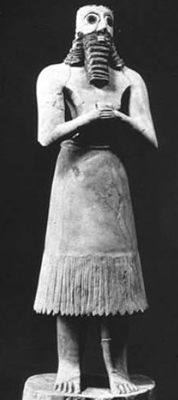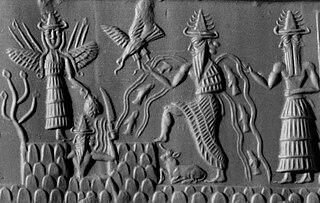Related Research Articles

Nergal was a Mesopotamian god worshiped through all periods of Mesopotamian history, from Early Dynastic to Neo-Babylonian times, with a few attestations under indicating his cult survived into the period of Achaemenid domination. He was primarily associated with war, death, and disease, and has been described as the "god of inflicted death". He reigned over Kur, the Mesopotamian underworld, depending on the myth either on behalf of his parents Enlil and Ninlil, or in later periods as a result of his marriage with the goddess Ereshkigal. Originally either Mammitum, a goddess possibly connected to frost, or Laṣ, sometimes assumed to be a minor medicine goddess, were regarded as his wife, though other traditions existed, too.

Utu, also known under the Akkadian name Shamash, was the ancient Mesopotamian sun god. He was believed to see everything that happened in the world every day, and was therefore responsible for justice and protection of travelers. As a divine judge, he could be associated with the underworld. Additionally, he could serve as the god of divination, typically alongside the weather god Adad. While he was universally regarded as one of the primary gods, he was particularly venerated in Sippar and Larsa.

Shala (Šala) was a Mesopotamian goddess of weather and grain and the wife of the weather god Adad. It is assumed that she originated in northern Mesopotamia and that her name might have Hurrian origin. She was worshiped especially in Karkar and in Zabban, regarded as cult centers of her husband as well. She is first attested in the Old Babylonian period, but it is possible that an analogous Sumerian goddess, Medimsha, was already the wife of Adad's counterpart Ishkur in earlier times.
Enbilulu was a Mesopotamian god associated with irrigation, and by extension with both canals and rivers. The origin of his name is unknown, and there is no agreement among experts in which way he was related to the similarly named deities Bilulu and Ninbilulu. While originally an independent deity, he eventually came to be seen as a name of Marduk and is mentioned in this role in the Enūma Eliš.
Ninti was a Mesopotamian goddess worshiped in Lagash. She was regarded as the mother of Ninkasi. She also appears in the myth Enki and Ninhursag as one of the deities meant to soothe the eponymous god's pain. In this text, her name is reinterpreted first as "lady rib" and then as "lady of the month" through scribal word play.

Abu was a Mesopotamian god. His character is poorly understood, though it is assumed he might have been associated with vegetation and with snakes. He was often paired with the deity Gu2-la2, initially regarded as distinct from Gula, but later conflated with her.
Ningirida was a Mesopotamian goddess regarded as the wife of Ninazu and mother of Ningishzida. Little is known about her character beyond her relation to these two gods.
Enmesharra was a Mesopotamian god associated with the underworld. He was regarded as a member of an inactive old generation of deities, and as such was commonly described as a ghost or resident of the underworld. He is best known from various lists of primordial deities, such as the so-called "theogony of Enlil," which lists many generations of ancestral deities.
Earth and Heaven were worshiped by various Hurrian communities in the Ancient Near East. While considered to be a part of the Hurrian pantheon, they were not envisioned as personified deities. They were also incorporated into the Mesopotamian pantheon, possibly during the period of Mitanni influence over part of Mesopotamia, and under the names Hahharnum and Hayyashum appear in a variety of texts, including the myth Theogony of Dunnu.

Isimud was a Mesopotamian god regarded as the divine attendant (sukkal) of the god Enki (Ea). He was depicted with two faces. No references to temples dedicated to him are known, though ritual texts indicate he was worshiped in Uruk and Babylon. He was also incorporated into Hurrian religion and Hittite religion. In myths, he appears in his traditional role as a servant of Enki.
Birtum was a Mesopotamian god who was the husband of Nungal. He was regarded as a deity associated with the underworld.
Duttur was a Mesopotamian goddess best known as the mother of Dumuzid. She frequently appears in texts mourning his death, either on her own or alongside Geshtinanna and Inanna. It is often assumed that she was associated with sheep.

Anu or Anum, originally An, was the divine personification of the sky, King of the gods, and ancestor of many of the deities in ancient Mesopotamian religion. He was regarded as a source of both divine and human kingship, and opens the enumerations of deities in many Mesopotamian texts. At the same time, his role was largely passive, and he was not commonly worshiped. It is sometimes proposed that the Eanna temple located in Uruk originally belonged to him, rather than Inanna, but while he is well attested as one of its divine inhabitants, there is no evidence that the main deity of the temple ever changed, and Inanna was already associated with it in the earliest sources. After it declined, a new theological system developed in the same city under Seleucid rule, resulting in Anu being redefined as an active deity. As a result he was actively worshiped by inhabitants of the city in the final centuries of history of ancient Mesopotamia.

Kassite deities were the pantheon of the Kassites, a group inhabiting parts of modern Iraq, as well as Iran and Syria, in the second and first millennia BCE. A dynasty of Kassite origin ruled Babylonia starting with the fifteenth century BCE. Kassites spoke the Kassite language, known from references in Mesopotamian sources. Many of the known Kassite words are names of Kassite deities. Around twenty have been identified so far. The evidence of their cult is limited, and only two of them, Šuqamuna and Šumaliya, are known to have had a temple. Other well attested Kassite deities include the presumed head god Ḫarbe, the weather god Buriaš, the sun god Saḫ and the deified mountain Kamulla.

Sukkal was a term which could denote both a type of official and a class of deities in ancient Mesopotamia. The historical sukkals were responsible for overseeing the execution of various commands of the kings and acted as diplomatic envoys and translators for foreign dignitaries. The deities referred to as sukkals fulfilled a similar role in mythology, acting as servants, advisors and envoys of the main gods of the Mesopotamian pantheon, such as Enlil or Inanna. The best known sukkal is the goddess Ninshubur. In art, they were depicted carrying staves, most likely understood as their attribute. They could function as intercessory deities, believed to mediate between worshipers and the major gods.
Ugur or Uqur (dU.GUR) was a god worshiped in various parts of the Ancient Near East. He was connected with the Mesopotamian deity Nergal. Much like him, he was associated with war and death. He was also originally regarded as Nergal's sukkal.
Idlurugu or Id (dÍD) was a Mesopotamian god regarded as both a river deity and a divine judge. He was the personification of a type of trial by ordeal, which shared its name with him.
Alla or Alla-gula was a Mesopotamian god associated with the underworld. He functioned as the sukkal of Ningishzida, and most likely was a dying god similar to Dumuzi and Damu, but his character is not well known otherwise. He had his own cult center, Esagi, but its location is presently unknown.

Epithets of Inanna were titles and bynames used to refer to this Mesopotamian goddess and to her Akkadian counterpart Ishtar. In Mesopotamia, epithets were commonly used in place of the main name of the deity, and combinations of a name with an epithet similar to these common in ancient Greek religion are comparatively uncommon. Inanna had more titles than any other Mesopotamian deity. They pertained to her associations with specific cities or areas, such as Uruk, Zabalam, Akkad, Nineveh, or the Sealand. Others instead highlighted her specific roles, for example, that of an astral goddess personifying the planet Venus—or that of a war deity. In some cases, her individual epithets eventually developed into separate deities.
Ancestors of Enlil or Enki-Ninki deities were a group of Mesopotamian deities. Individual lists do not agree on their number, though the enumerations always start with the pair Enki and Ninki and end with Enlil. They were regarded as primordial, ancestral beings who were no longer active and resided in the underworld. They could be invoked in exorcisms. They are attested in various texts, including god lists, incantations, prayers and myths.
References
- 1 2 3 4 Lambert 2013, p. 523.
- 1 2 3 4 5 6 7 8 9 Lambert 1983, p. 431.
- ↑ Krebernik 2013, pp. 314–315.
- 1 2 3 Lambert 2013, p. 388.
- ↑ Wiggermann 2011, p. 683.
- 1 2 3 Wiggermann 2011, p. 672.
- ↑ Katz 2008, p. 336.
- ↑ Lambert 2013, p. 525.
- ↑ Wiggermann 2011, p. 669.
- ↑ Black 2006, p. 225.
- 1 2 Lambert 2013, p. 390.
- ↑ Lambert 2013, p. 381.
- ↑ Black 2006, p. 226.
- ↑ Geller 2015, p. 204.
- 1 2 Lambert 2013, p. 391.
- ↑ Lambert 2013, p. 387.
- ↑ Lambert 2013, p. 392.
Bibliography
- Black, Jeremy A. (2006). The Literature of Ancient Sumer. Oxford University Press. ISBN 978-0-19-929633-0 . Retrieved 2022-10-10.
- Geller, Markham J. (2015). Healing Magic and Evil Demons. De Gruyter. doi:10.1515/9781614513094. ISBN 978-1-61451-309-4.
- Katz, Dina (2008). "Enki and Ninhursaga, Part Two". Bibliotheca Orientalis. Peeters Publishers. 65 (3): 320–342. doi:10.2143/bior.65.3.2033365. ISSN 0006-1913.
- Krebernik, Manfred (2013), "Šunidug", Reallexikon der Assyriologie (in German), retrieved 2022-10-11
- Lambert, Wilfred G. (1983), "Laḫar", Reallexikon der Assyriologie, retrieved 2022-10-11
- Lambert, Wilfred G. (2013). Babylonian creation myths. Winona Lake, Indiana: Eisenbrauns. ISBN 978-1-57506-861-9. OCLC 861537250.
- Wiggermann, Frans A. M. (2011). "Agriculture as Civilization: Sages, Farmers, and Barbarians". Oxford Handbooks Online. Oxford University Press. pp. 662–689. doi:10.1093/oxfordhb/9780199557301.013.0031. ISBN 978-0199557301.